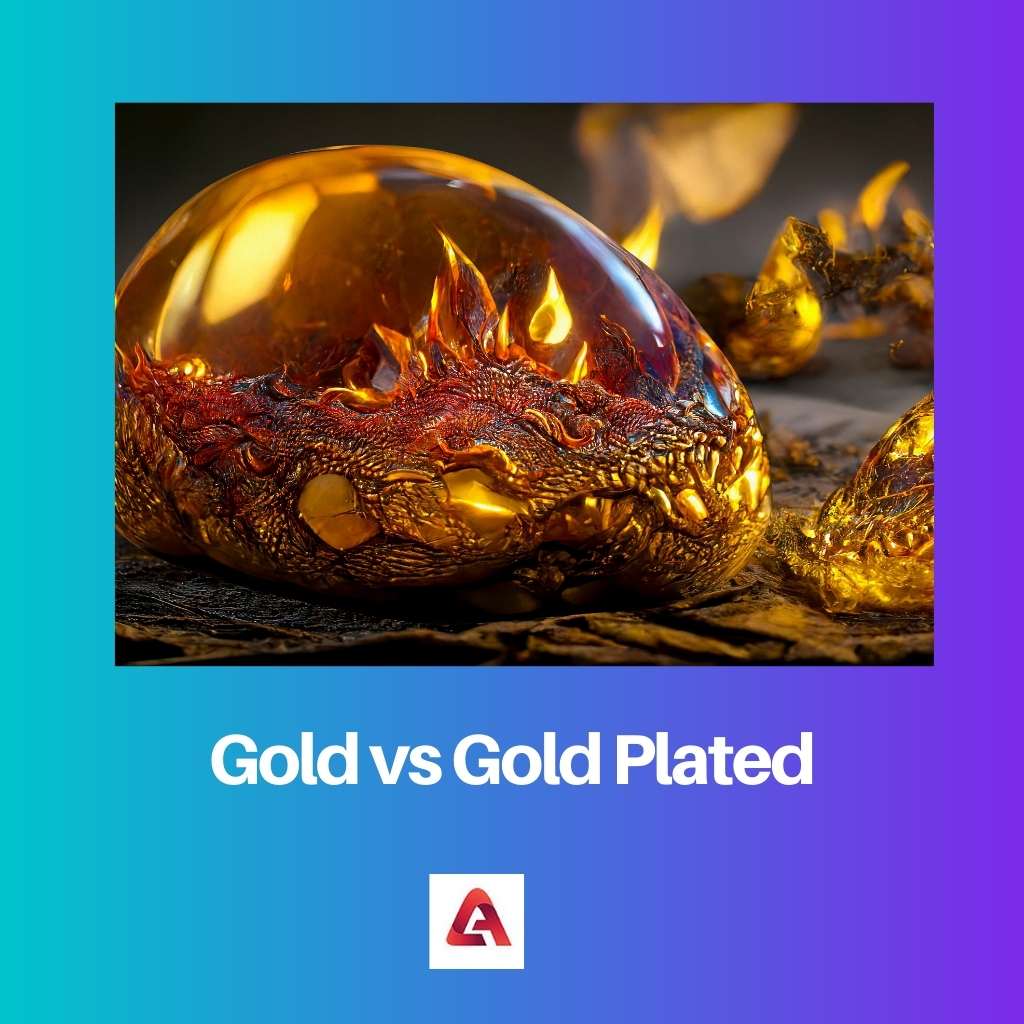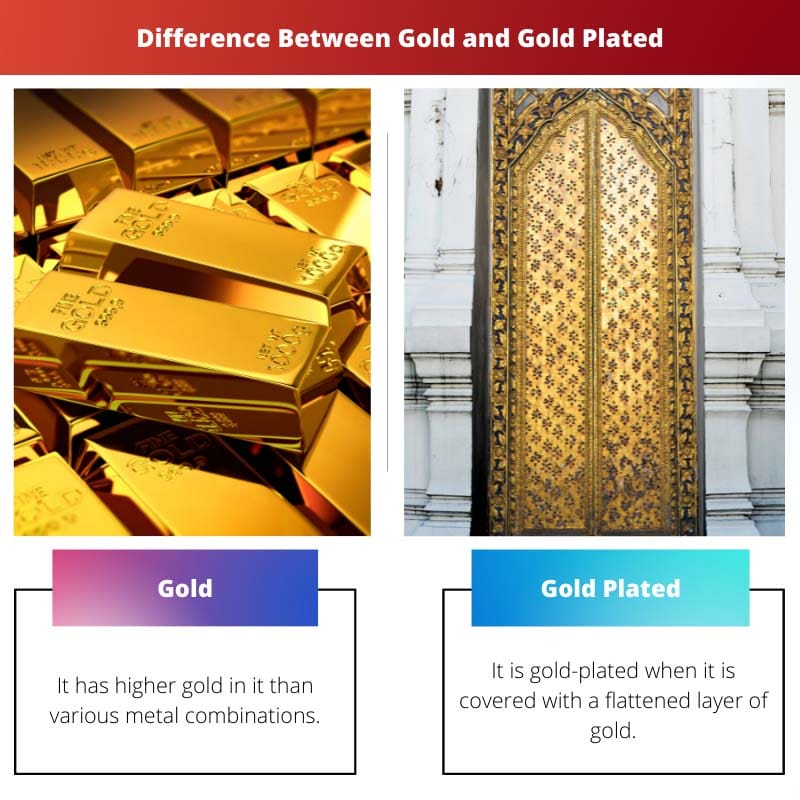Jewellery composed of pure gold or with a gold coating is referred to as gold or gold-plated. Gold content, worth, quality, endurance, and affordability differ.
Both are renowned jewellery metals; however, despite their similarities, they are not similar metals.
One is a stratified gold alloy applied on a parent metal, while the other is a tiny coating of gold plating linked to substrate metal.
Key Takeaways
- Gold is a precious metal valued for its rarity, beauty, and intrinsic worth.
- Gold-plated items consist of a base metal coated with a thin layer of gold.
- Gold-plated jewelry is less expensive and less durable than solid gold pieces.
Gold vs Gold Plated
“Gold is a chemical element with the symbol Au (from the Latin word aurum, meaning””shining dawn”). It is a dense, soft, yellow metal that is highly valued for its beauty and rarity. Gold-plated refers to a thin layer of gold that is deposited onto a surface through a process known as electroplating. This involves passing an electric current through a solution containing dissolved gold. “Gold is a chemical element with the symbol Au (from the Latin word aurum, meaning “shining dawn”). It is a dense, soft, yellow metal highly valued for its beauty and rarity. Gold-plated refers to a thin layer of gold that is deposited onto a surface through a process known as electroplating. This involves passing an electric current through a solution containing dissolved gold.

In gold, Coatings of gold are linked to melodic metalcore. While it may sound comparable to gold plating, it is not the same in manufacture and lifespan.
Instead of one exterior layer of pure gold, gold-filled jewellery includes strata of a gold alloy. This is a crucial attribute since it results in a jewellery metal that is more robust and long-lasting.
Gold is 100 per cent pure gold in its native condition, with no plated metals added.
In gold-plated, a thin coating of gold alloy is attached to a metal matrix such as brass, iron, aluminium, or sovereign silver to create gold-plated jewellery.
Base metal is present because gold-plating imitates the appearance of exquisite gold jewellery without cost. In other terms, the jewellery contains merely a trace of genuine gold.
Gold-plated jewellery is a low-cost option that works well for fashion jewellery.
Comparison Table
| Parameters of Comparison | Gold | Gold Plated |
|---|---|---|
| Identity | It has higher gold in it than various metal combinations. | It is gold-plated when it is covered with a flattened layer of gold. |
| Durability | The overall item is resistant to gold, including the precious metals and the compositions. | The overall item may be resilient in gold-plated contingent on the elements employed, but the gold covering won’t endure long. |
| Value | Because of its high gold percentage, gold is more precious. | Because of the unfathomable gold amount coated on it, gold-plated is less precious. |
| Price | Wearing Gold-filled jewellery when dealing with water is fine. | Gold plating is cheap. |
| Nature | Wearing Gold-filled jewelry when dealing with water is fine. | Gold-plated is not ideal for regular wear. |
What is Gold?
There are two types of gold: bare gold and gold-filled. In summary, solid gold is highly valued regarding texture, purity, and affordability. It has the most radiance and brilliance.
However, pure gold is rarely utilized in jewellery because of its mutability and tenderness. Even though it is a valuable precious metal, its jewellery will not endure long daily.
Gold is alloyed with other metals to make it highly resilient. With the inclusion of alloys, the karat, a metric of the fineness of gold, drops.
Gold-filled substances have a higher gold density than gold-plated substances. A solitary coating of double-layer might cover the interior metal combination.
While gold-filled is comparable to genuine gold, it has the same attributes and an attractive look. It is less expensive and lasts longer. Because of its low cost and longevity, gold-filled jewellery is popular.
Although gold-filled materials contain additional gold, unlike electroplated gold materials, they do not crack or alter colour when subjected to water.
People can take a bath while wearing a gold-filled wristband or ring without it scraping off.
Because gold-filled jewellery does not cause adverse responses in those who are inflammatory to other metals, it is suitable for them. These types of jewellery may survive for up to 30 years.

What is Gold Plated?
Gold-plated jewellery is probably the most prevalent type in the industry, as it is a less expensive option than solid-gold but also gold-filled jewellery.
Electroplating is applying a thin layer of gold to numerous metals to provide them with a goldish, attractive look.
In terms of endurance, the gold-plated substance may be robust, but the lacquer will not be. Sometimes a gentle knuckle swipe is all that is required to eradicate the coating.
Gold-plated jewellery can chip and discolour in a short amount of time. Because it is prone to damage, it should not be donned when bathing or performing any work that may expose it to extreme climatic circumstances.
It is helpful for some instances, such as fashion jewellery sets, where the attractive look outweighs the durability. The substances are not appropriate for frequent use.
Onn the other hand,Jewellers can deceive buyers by delivering a gold-plated item at the price of a gold-filled item.
In such instances, performing experiments such as the acid check and the magnetized test is critical. More acid is more powerful, and it will expose the metal’s identification.
The magnetic analysis, unfortunately, is not definitive because there might be several defects. Other nonmagnetic alloys, for example, might be employed.

Main Differences Between Gold and Gold Plated
- When jewellery is gold-plated, an incalculable proportion of gold is utilized, making the item less expensive. Whereas gold-filled jewellery contains more gold than gold-plated jewellery, it is more precious.
- Gold-plated substances are solely gold-plated. A thin, infinitesimal layer upon the gold gives the substance the gleaming appearance of gold. A gold substance, on the other hand, contains more gold. Typically, it is around 20%.
- Gold-plated jewellery is long-lasting, but the covering is not. Especially if exposed to extreme weather conditions like rain. A gold substance, on the other hand, is long-lasting. Solid gold becomes even more durable when mixed with tough metals such as nickel.
- The value of the gold-filled and straight metal is higher. Gold-plated items are less valuable, even if covered with a thin layer of 24-carat gold.
- A flimsy layer of gold is rhodium plated on gold-plated. While solid gold is nobler, it is rarely employed in jewellery.

- https://www.sciencedirect.com/science/article/pii/S0959652607001497
- https://onlinelibrary.wiley.com/doi/abs/10.1111/j.0105-1873.2005.00522.x

This article presents a compelling comparison between gold and gold-plated jewelry.
It is fascinating to learn about the subtle differences between gold and gold plated items.
The article does a great job of explaining the differences between gold and gold-plated jewelry in a precise and clear manner.
I did not know that gold-filled jewelry had a higher gold content and durability compared to gold-plated jewelry.
Very informative article. I now feel knowledgeable about gold content and its value.
It’s interesting how gold-filled jewelry is longer-lasting and contains a higher gold density than gold-plated items.